“Maybe we can just pretend that we went,” I thought to myself as our Uber’s estimated time of arrival extended from seven minutes to half a century. After 15 minutes of waiting and two missed calls to the Uber driver later, we canceled the ride and ordered another one. This time, a lovely gentleman named Daran picked us up. Little did I know that this man would soon become my best friend. After discussing his graduate studies at Georgia Tech, war, my family origins and global warming, I wondered whether I could ask Daran for his number, knowing that I would probably want to catch up with him later and find out how he and his girlfriend were doing. Sadly, we live in an imperfect world dictated by social norms that deem asking your Uber driver for personal information to spark a friendship “weird”.
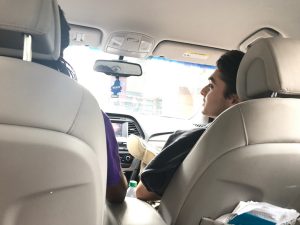
When we arrived at Centennial Olympic Park, I shook Daran’s hand, wished him and his girlfriend the best, and sadly bid him adieu. “Wow,” I thought to myself as we exited the Uber to see the historically significant and beautiful Centennial Olympic Park before us, “this is about to be really boring.” All I could think about, besides Daran, was that I would finally get to walk backward with Jared.
We began our journey by learning about the park’s origins. The park commemorates the 1996 Centennial Summer Olympic Games, which Atlanta hosted. The city dedicated $75 million to developing Downtown Atlanta, ensuring it was fit to house the games and creating a commercial center in Atlanta, including the Georgia Aquarium, Center for Civil and Human Rights, College Football Hall of Fame, CNN, Delta Airlines and the World of Coca-Cola. Centennial Park continues the legacy of the 1996 games and its subsequent impact on Atlanta.
Confused about where to begin our exploration of the park, we were relieved to find that it had an accompanying Audio Tour. Today, we will take you along with us as we tour the park and share our experiences.
Allen Family Tribute
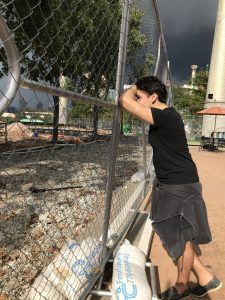
Our tour begins with the Allen Family Tribute. This 15-foot-tall structure pays tribute to the three generations of the Allen family, who helped shape the city of Atlanta. On the note of family, this part of the park always reminds me of my first experience at Centennial Olympic Park nearly six years ago with my family. My parents were so excited to show me and my younger brother the spot where they watched the 1996 Olympic Games together, and I vividly remember them pointing out this landmark as a testimonial to the importance of family. Come along so we can see what else this place has in store…
Gateway of Dreams
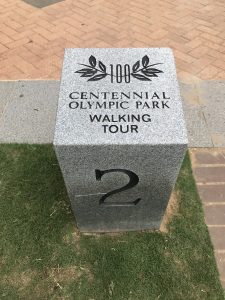
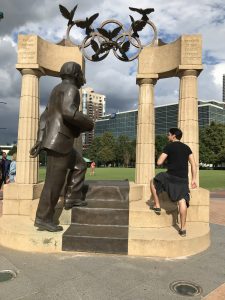
The Gateway of Dreams is a monument of Baron Pierre de Coubertin, the father of the modern Olympic Games. Coubertin’s sculpture is three times his height, representing his legacy and impact on the Olympics. The plaque below the sculpture describes Coubertin’s “dream of a world united in peace through sport.” But the only thing going through my mind was that this man could rock the stache, and honestly, not everyone can. I bet Hunter could, though.
Androgyne Planet

“What do aliens have to do with the Olympic Games?” I thought as I looked up at the vast statue before me and put on my tin foil hat. This totem represents the Games’ spirit of international unity. To create this spirit of unity, each host city donates a piece of art to the next city. At least my tin foil hat won’t let the statue’s telekinetic powers into my brain. This is what the planet must really be built for, let’s be honest.
Children’s Garden and Playground
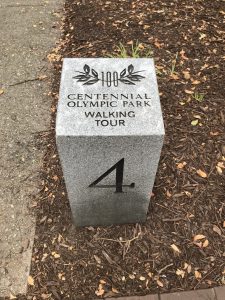

We are now stepping on the rubber floors of the Centennial Olympic Park’s Children’s Playground. This play space is dedicated to the younger kids that frequent the park and is designed for children with all ranges of physical abilities. The aisles between various activities are wide, and all activities on the playground are accessible, capturing the essence of the park as an all-inclusive venue. I am reminded of my frequent trips to Aiden’s Playground, an accessible park in Los Angeles, with my mother, previously a Disability Rights Lawyer, who was highly supportive of its design.
Paralympic Legacy
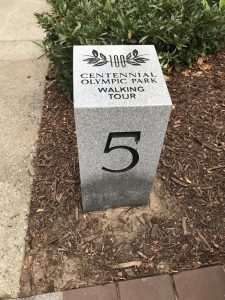
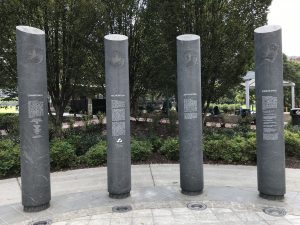
On the note of inclusivity, the monument that we are now approaching commemorates the Atlanta Paralympic Games, a sports competition for athletes with disabilities. The pillars that surround the monument represent the commitment, leadership, diversity, and excellence that characterized the 1996 Atlanta Paralympic Games. “Paralympic Legacy” serves as a reminder of the pursuit of excellence that the Paralympics inspire.
Quilt of Nations
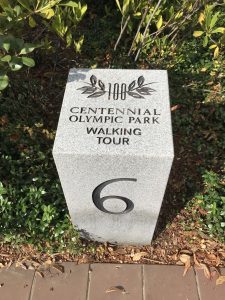
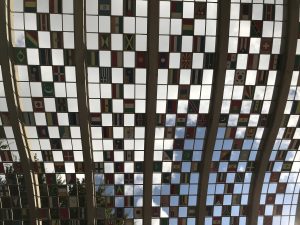
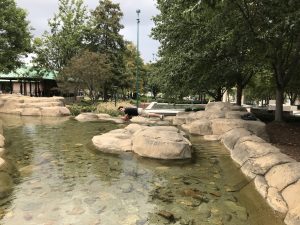
A man-made series of beautifully landscaped, cascading water features weave through the five Quilt Plazas, including the Quilt of Nations. The Quilt of Nations honors all 197 nations that participated in the 1996 Games. This was the largest number of countries ever represented in the history of the Olympic Games. Seeing the flag of the Country of Georgia, I feel a sense of pride that Georgia was a part of this historical Olympic Games. For the first time, I began to realize the significance of the park.
Quilt of Olympic Spirit
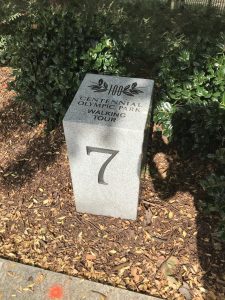
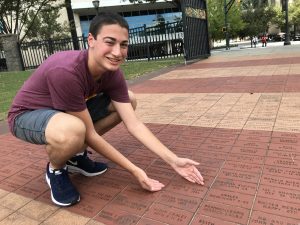
This landmark salutes the 10,000 athletes who participated in the 1996 Centennial Olympic Games. Inscribed in granite is a list that names all 184 medalists. The names “Soso Liparteliani” and “Eldar Kurtanidze” immediately catch my attention. Not only did I meet these Georgian Olympic medalists personally, but seeing these names reinforces the park’s focus on international unity. These names were engraved beside those of fellow Russian athletes, citizens of the same country that occupied Georgian territories and bombed our cities 12 years later.
Quilt of Origins

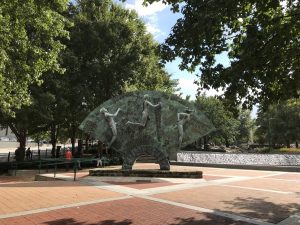
We’re now at the Quilt of Origins, a sculpture that depicts the advancement of the Olympic Games from ancient Greece until today. The work of art weighs eight tons and features three figures: a nude man (representing Greece – where the first Olympics were held), another man who looks much more contemporary (representing the style of the modern Olympics), and a female (representing the Atlanta Olympic Games). As you can see, there are bricks implanted in the pathways all around us, covering the entire park. These bricks are the names of the individuals who donated in securing this structure that stands before us. My parents even purchased one, serving as a unique reminder of their time that they spent living in Atlanta. Let’s now go on to the Quilt of Remembrance.
Quilt of Remembrance
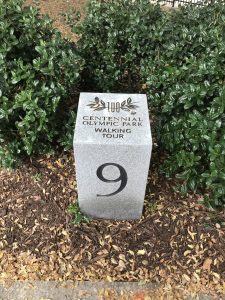
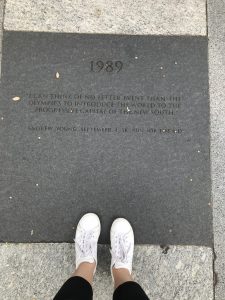
This mosaic acts as a reminder for those who were injured from the bomb that went off during the Atlanta Olympics. 111 stones are placed here from all around the world to pay respect to the 111 people hurt by the bombing. My parents remember hearing the bomb at the Olympics, and the chaotic scene that followed. They, like the rest of the world, also remember the Games reopening soon after this domestic terrorist attack, serving as a triumph of the human spirit and great character of Atlanta. Alice Hawthorne was the only person who died from this tragedy, and the eternal light is always shining at this site in her memory.
Quilt of Dreams
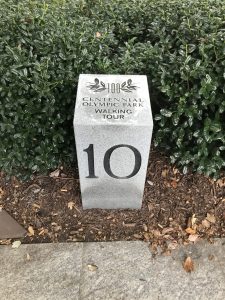
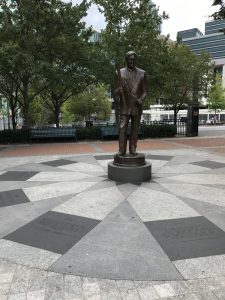
The quilt above us holds tribute to Billy Payne, CEO of the Atlanta Committee for the Olympic Games. Payne is responsible for bringing the Olympics to Atlanta, a 10 year quest that was successful on its first bid. Another dream of Payne’s, this park is the physical manifestation of countless inspirational feats. As we walk along the quilt, I would like to point out a quote that encompasses the importance of the Atlanta Olympics: “I can think of no better event than the Olympics to introduce the world to the progressive capital of the new South” (Andrew Young). In a sense, exploring Centennial Park has introduced me to downtown Atlanta – to its many opportunities and its deeper significance.
Hermes Towers/Centennial Plaza

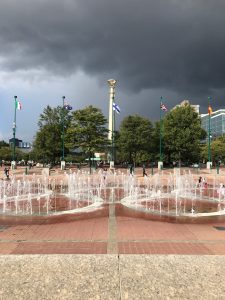
Even the dimensions of our next stop are symbolic. Centennial Plaza is 100 meters squared, equivalent to the distance of the 100 meter Olympic race. The flags of the 23 past host cities circle the Plaza. Eight “Hermes Towers” are also mounted around the Plaza to emulate the indicators that directed Ancient Greek spectators to public happenings.
Fountain of Rings
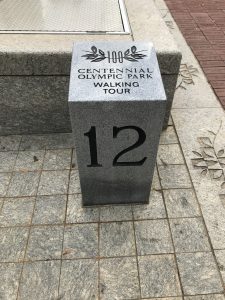
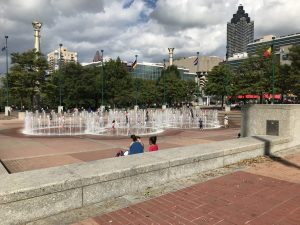
We’re now at one of the most iconic landmarks in this park and the city of Atlanta…the Fountain of Rings. The fountain has four daily shows (at 12:30 p.m., 3:30 p.m., 6:30 p.m., and 9:00 p.m.) that combine music, lighting, and, of course, water. The fountain is also a great place to play and relax. I still see a view of the fountain whenever I take an airplane ride from Cleveland to Atlanta, and this reminds me of the Olympic Games my parents attended as well as my family’s Atlanta history.
Southern Company Amphitheater
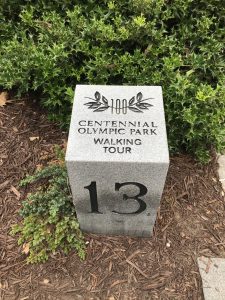
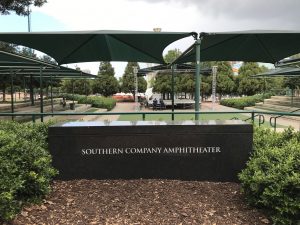
We will now conclude our tour at the location that embodies the true purpose of Centennial Olympic Park as a communal space. This open venue hosts events on 186 days of the year, committed to providing free entertainment for the whole family. Olympic Park is central to the Atlanta community, appealing to individuals of all ages and all ranges of ability. All visitors need is the openness to learn and to be inspired.
Our Uber ride back simply wasn’t the same. I did not connect to our driver in a powerful way. Perhaps this is because I didn’t get to tell him about the public executions of my great-grandfathers or because I was too side-tracked reflecting on my ultimately positive experience of Centennial Olympic Park. The park inspired thoughts about unity, peace, and internationality. But a single thing I had learned from the day’s outing truly stuck out to me: “Humanity is always being tested in some way, shape or form” (Daran).
“God damn it Daran, why didn’t I ask for your number?”
To follow along on the official audio tour that inspired this post, please visit https://www.gwcca.org/park/visiting-the-park/audio-tour/.
